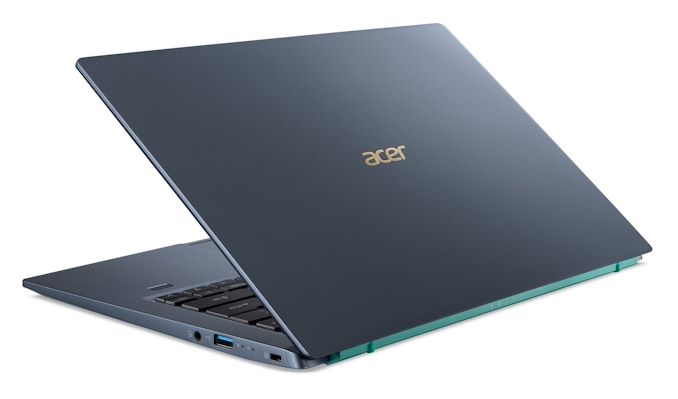Acer’s New Swift 3X Notebook, with Intel Iris Xᵉ MAX Discrete Graphics, from $900
by Dr. Ian Cutress on October 21, 2020 9:45 AM EST
At Acer’s global press conference today, one of the hot ticket items was the announcement of an upcoming laptop featuring an Intel’s discrete graphics option. The new Intel Xe graphics architecture, which debuted in Intel 11th Gen Tiger Lake notebook processors, is now set to see the launch of an additional higher power discrete graphics option and coming to notebooks first. One of those devices will be the Acer Swift 3X, with both Tiger Lake and discrete Xe MAX inside.
The Swift 3X (SF314-510G) is a notebook with a 14-inch 1080p IPS display, peaking at 300 nits brightness, and will be offered with up to 16 GB of LPDDR4X memory as well as 512 GB of Optane+QLC or up to 1 TB of NVMe storage. The unit will have Wi-Fi 6 support, and is rated for up to 17.5 hours battery life. Weight tips the scales at 3 lbs.
This device seems like a typical Swift 3-esque notebook, with a backlit chicklet keypad, a good sized trackpad, a fingerprint scanner, good bezels, and a webcam up top. The hinge mechanism lifts the laptop up slightly to create some additional airflow. There is a HDMI output, two full sized USB Type-A, and a Type-C that could be Thunderbolt but it is unclear.
Processor options are the top line Intel Core i7-1165G7 or Core i5-1135G7 – there’s no direct indication about what power level these are set to (a drawback of Intel’s non-fixed TDP marketing messaging), so these could very well be 12 W models with 1.2 GHz base frequency.
All that information aside, what you’re really after is the Intel Iris Xe MAX discrete graphics information – core counts, frequencies, power consumption, that sort of thing. Unfortunately Acer hasn’t released any additional information here – the chassis looks sturdy enough that it can handle some extra wattage above the 12 W suggested for Tiger Lake at least.
What you might be shocked to find out is that this model is due for release in China by the end of the month. This might be because entry level discrete graphics options are more favored in the APAC market. We’ve asked Acer if they can expand on reasoning here – it may very well be supply chain oriented due to the pandemic.
Acer plans to launch the unit in China first in October, Europe in November, and North America in December. Prices will start at $900 / €850 / 4999 RMB.
Related Reading
- Intel’s Tiger Lake 11th Gen Core i7-1185G7 Review and Deep Dive: Baskin’ for the Exotic
- Intel Launches 11th Gen Core Tiger Lake: Up to 4.8 GHz at 50 W, 2x GPU with Xe
- Seeing Is Believing: Intel Teases DG1 Discrete Xe GPU With Laptop
- What Products Use Intel 10nm? SuperFin and 10++ Demystified
- The Acer Nitro 5 Review: Renoir And Turing On A Budget
- The Acer Swift 3 SF314 Notebook Review: Swift Gets Swifter With Ryzen 4000
- Acer Launches Cheap USB-C Monitor for Laptops: The 15.6-Inch Acer PM1



















39 Comments
View All Comments
Vitor - Wednesday, October 21, 2020 - link
If the screen is actually decent, it would be a good buy. 16bg ram and 1080 is enough for me.cfenton - Wednesday, October 21, 2020 - link
The regular Swift 3 has one of the worst screens in a modern laptop, so I wouldn't expect any miracles.Spunjji - Thursday, October 22, 2020 - link
Who knows, maybe they were saving all the good screens for this one...sharathc - Friday, October 23, 2020 - link
It covers 72% of the NTSC gamut. Is it good?Link: https://www.acer.com/ac/en/IN/content/series/swift...
Jorgp2 - Wednesday, October 21, 2020 - link
>Processor options are the top line Intel Core i7-1165G7 or Core i5-1135G7 – there’s no direct indication about what power level these are set to (a drawback of Intel’s non-fixed TDP marketing messaging), so these could very well be 12 W models with 1.2 GHz base frequencyIan why do you keep stating this like its a new thing, OEMs could always change the TDP and turbo of CPUs. Cooling also affects performance.
Intel is just lining up their specs to what actually happens in the real world, the OEM will just set whatever power configs they're comfortable with.
That's why you should always look for laptops, not laptop CPUs.
It's the same for AMD, why look for a 4800U laptop without checking to see if it has a 10w TDP with 8w of cooling?
Especially since CPPC defines how efficient the CPU will be, not the actual power config itself.
Ian Cutress - Thursday, October 22, 2020 - link
Because Intel has changed its messaging stance to obfuscate. Presentations from partners are saying the 1165G7 has a base frequency of 3.0 GHz, regardless of what power mode it's actually running at, because when the marketing team go looking for the stats on its own hardware, that's the result they get when the processor SKU is looked up.Jorgp2 - Thursday, October 22, 2020 - link
>Because Intel has changed its messaging stance to obfuscate. Presentations from partners are saying the 1165G7 has a base frequency of 3.0 GHz, regardless of what power mode it's actually running atIan, you don't understand. OEMs were already lowering the TDP of U series SKUs to Y series power levels, that changes the base clock.
But the OEM still advertised the 15w base clock, and the 15w turbo.
Same for OEMs that locked PL1&2 to 28w.
Spunjji - Thursday, October 22, 2020 - link
Turbo, yes. TDP, no?"Intel is just lining up their specs to what actually happens in the real world"
How can you "line up" a spec that *isn't there*? This is the worst rationalization. "The situation was terrible, so they're being pragmatic by making it worse". 🤦♂️
Spunjji - Thursday, October 22, 2020 - link
Let me put it this way: if they have the clout to drag partners into their Evo program and lock AMD out of high-end gaming laptops, then they have the clout to post multiple specifications for their SoC and dictate which spec their partners use based on what their chassis design is capable of cooling. You'd still see *some* variation in, say, long-duration testing - but you wouldn't get this absolute madness where you have no idea what the guaranteed base clock of the CPU you just bought is.Jorgp2 - Thursday, October 22, 2020 - link
Yes, and no.TDP can be changed by changing the PL1.